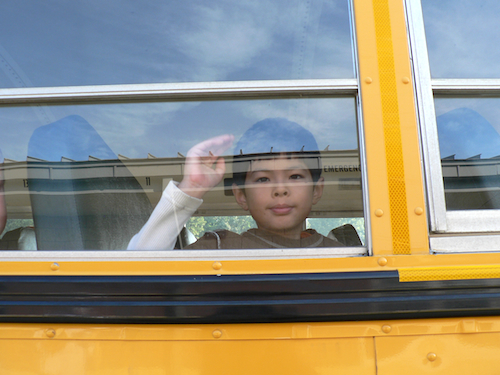All I want for my kids is a good public education. I’m trying to figure out what that is, where it can be found and what are the alternatives if it no longer exists.
Public schools – State comparisons
Public school rankings are tricky in a nation whose public school system has been struggling for decades. And each state has its own testing system, which makes it difficult to compare across state borders.
Money matters. But it isn’t everything. California spends about $10,000 per pupil each year, slightly below the national average, and its test scores are near the bottom – a dismal 42% proficiency for reading and math among 6th graders, according to NeighborhoodScout.com, which attempts to equalize state testing scores for comparison purposes.1 New York and New Jersey spend about $16,000 per pupil – 60% more. Those states also have much higher test scores.
Some programs do more with less: Virginia spends around the same per pupil as California with much better results – its test scores are dramatically higher and its average class size dramatically lower. Other programs have problems that go deeper than funding: Washington, DC spends over $18,000 per pupil with infamously dismal results.
Certainly demographics play a role. California has a huge percentage of recent immigrants compared to many states. California’s Hispanic population is 48.5%, vs the 19.9% national average. But Texas – which has a 45.3% Hispanic population and an economically disadvantaged population similar to California’s (48.2% vs 47.6% in CA and 41.4% nationwide) – actually spends 10% less per pupil on education, and its test scores rank at the top of this state sampling, vs California which is squarely at the bottom.
Why are California’s scores so pathetically low? I have heard that California state tests are among the nation’s most rigorous. It is possible the data from NeighborhoodScout.com does not adequately correct for level differences among state tests. And certainly testing is a flawed measurement of actual student learning and performance. Still, results like this are not encouraging for Californians.
Average class size is another indicator. The nationwide average – technically the ratio of pupils to teachers – is 15.6 (actual class sizes are higher). At nearly 21, California’s average class size is more than 30% higher than the US average. In this limited state sampling, increased spending per pupil does seem to buy lower class sizes (with the notable exceptions of Virginia and Texas, which spend less and also have low class sizes). Based on a more local analysis I did of public schools in Silicon Valley, spending per pupil does appear to relate more directly to class size than to performance.
Some data (horizontal line is nationwide average):
[easychart type=”vertbar” height=”200″ width=”300″ title=”Public Education Spending by State” groupnames=”Spending per pupil” valuenames=”NJ, NY, MA, MD, OH, VA, CA, TX” group1values=”16486, 15990, 13860, 12092, 11102, 10579, 10013, 8911″ minaxis=”6000″ watermark=”10400, 10500″]
[easychart type=”vertbar” height=”200″ width=”300″ title=”Student Performance by State” groupnames=”Grade 6 reading proficiency, Grade 6 math proficiency” valuenames=”NJ, NY, MA, MD, OH, VA, CA, TX” group1values=”75, 60.4, 67, 76.5, 77.7, 84, 42, 91″ group2values=”70.8, 60.5, 52, 71.9, 74, 59.7, 42, 79″ minaxis=”30″]
[easychart type=”vertbar” height=”200″ width=”300″ title=”Public Education Class Size by State” groupnames=”Average class size” valuenames=”NJ, NY, MA, MD, OH, VA, CA, TX” group1values=”12.38, 12.85, 13.20, 15.17, 15.59, 11.67, 20.81, 14.96″ minaxis=”10″ watermark=”15.60,15.70″]
[easychart type=”vertbar” height=”200″ width=”300″ title=”Economically Disadvantaged Students by State” groupnames=”% economically disadvantaged” valuenames=”NJ, NY, MA, MD, OH, VA, CA, TX” group1values=”26.8, 44.8, 28.2, 31.6, 32.5, 31.1, 47.6, 48.2″ minaxis=”20″ watermark=”41.3,41.6″]
Engagement and “extra” programs
There’s also the issue of engagement. Our children are primarily at school for the academics, but they have to be engaged in order to learn. This is why art, music and physical education are critical, not optional. I have to believe that schools that cut out physical education – some are even cutting recess – get the unintended result of restless, fidgety kids that are physically unable to focus. Children need the energy release for their good health – physical and mental. Art and music are creative breaks from listen-and-learn instruction. If they don’t have a diversity of activities during the long school day, kids will become disengaged, bored and frustrated.
Programs for gifted children, which unlike special education programs are not mandated, have also been underfunded or eliminated in recent years. According to educationweek.org, the federal government spends $11.5 billion on school-aged children with disabilities under the Individuals with Disabilities Education Act, compared with federal funding for gifted students at a miniscule $7.5 million. Even that small amount is at risk of being eliminated entirely.2
Certainly parents can supplement outside of school. But anyone with school-aged children knows that after a long school day and homework, kids have precious little interest or energy for anything that seems like additional work.
If schools thought more about engagement than achievement, they might approach elective programs differently. A local schools superintendent told me about an inspired approach that some schools have implemented, which is to allow teachers to create elective courses based on what they’d like to teach – the philosophy being that engaged teachers are more important in creating engaged students than the subject matter itself. My brother-in-law is an excellent high school teacher and coach, and this year he’s assigned to teach “Technology for Tomorrow,” which he jokes ruefully should be taught by the kids, as his background is in finance, not technology.
David McCullough, the famous American historian, is passionate about teacher engagement. He believes we need to emphasize subject matter expertise among teachers rather than teaching skills, because it’s the enthusiasm for the subject matter that makes more of an impact on children than teaching methods. Here’s a quote from a speech McCullough gave in 2005:
We have to do a far better job of teaching our teachers. We have too many teachers who are graduating with degrees in education. They go to schools of education or they major in education, and they graduate knowing something called education, but they don’t know a subject. They’re assigned to teach botany or English literature or history, and of course they can’t perform as they should. Knowing a subject is important because you want to know what you’re talking about when you’re teaching. But beyond that, you can’t love what you don’t know. And the great teachers – the teachers who influence you, who change your lives – almost always, I’m sure, are the teachers that love what they are teaching.
Homeschooling
I’d always recoiled at the idea of homeschooling my own kids. But now I see the sense of it. In total instruction time, primary schoolers probably only need two hours to equal the amount of direct, focused instruction they get in a day at school. The rest of the day is then freed up for reading, outdoor play, music or language lessons, outings to museums, farms, nature preserves. Homeschooling networks also provide opportunities to combine talents and provide increased socialization for kids.
Nationwide, 1.5 million students, or 2.9 percent, are homeschooled.3 Anecdotally it seems that homeschooling is gaining momentum as public schooling options have become less attractive. Here’s a quote from Homefires.com, whose tagline is “The Journal of Homeschooling Online”:
Homeschooling in California may have begun with the stereotypical image of religious fundamentalists and fringe element hippies, but today the booming growth is among mainstream parents, who find home education less radical than what is offered as “education” on some public and private school campuses.
Private schools
Nationwide 11% of students attend private school, with 15% in the Northeast, 11% in the Midwest, 10% in the South and 9% in the West.4
For many friends of mine in suburbs, private schools offer a specialized education philosophy or environment they cannot find elsewhere. For friends in urban environments, private schools are often the only good options. Other families are more comfortable sending their children to a parochial school consistent with their religious beliefs.
Certainly the cost of private schooling is significant. For some families, particularly those with multiple children, cost can be prohibitive. For other families of means, high cost may have a psychic correlation to quality. A local public schools superintendent, who has also served as an elementary school principal, noted pragmatically that some families gravitate toward private schools because they feel that a high tuition must provide benefits that a free public school cannot. I was surprised to learn from a member of my local school board in California that 38% of families in my town, which has some of the best public schools in the state, choose to send their kids to private school.
As with comparing public schools across states, it is difficult to compare private schools to public with any objectivity. I have seen a couple of studies that show that after controlling for socioeconomic and location factors, private school kids score lower than comparable public school kids, though one of those studies was later contradicted by a Harvard study using the same data.5,6,7,8 Either way, the fact that private schools provide a more select peer group than the broader local population may be a benefit in itself for many families.
Other issues to consider:
- Teacher quality: My mother was a public school teacher for her entire career, and her strong opinion is that public schools draw better teachers due to higher salary, benefits and job security. According to a National Center for Education Statistics report, “In 2007-08, the average annual base salary of regular full-time public school teachers ($49,600) was higher than the average annual base salary of regular full-time private school teachers ($36,300).”9
- Class size: Private schools may offer smaller class sizes, which, particularly in kindergarten and first grade, have been demonstrated to have lasting positive effects on student performance.10 This is less the case in parochial schools, whose class sizes tend to be more comparable to public schools.
- School size: A too-small school can be socially limiting. The anonymity of a too-large school can allow for more playground bullying. At the high school level, increased size can provide the scale for more advanced placement classes and athletic opportunities that smaller schools can offer.
My own experience
Maybe because it’s what I know, but I prefer the come-one-come-all philosophy of public schools for my own children. In my ideal world, kids start out in the sheltered world of family and family friends, then slowly get increased exposure to the world in stages – preschool, elementary school, middle school and high school – each level drawing back the curtain to a larger and broader sampling of the community than they had previously known. I hope by the end they will have gained experience interacting with a wide variety of people and perspectives and will be prepared to navigate the world on their own in college and beyond.
In each state there are good schools and not-so-good schools, depending on local funding and community support. The reality in California today is that the good school districts collect significant additional funds from their families to maintain programs and class sizes. In many districts the contribution is $600 a year per student; others are at least $1000 a year per student; in one local charter school, it’s a whopping $4500 a year per student, which is as much as some parochial school tuitions.
In Ohio we’ve found far superior facilities, art, music and physical education programs compared to the also excellent school district we came from in California – funds in Ohio coming from local property taxes rather than direct fundraising from parents. In both states we’ve found the academic experience and teachers to be very good, from our limited experience of two years in each place.
What I’ve concluded is that good public schools are everywhere, but they are harder to find in some states than others. In California, I am troubled by the growing inequality between the best districts, which can raise hefty supplemental funding either through taxes or direct contributions, vs regular districts that can’t. Along with the widening income gap over the last 30 years in the US, the education gap has become vast. Pockets of good public education are available to those with means. But what about everyone else?
What it means and where it’s going
I know we can never have equality among schools. But particularly in this era of knowledge workers, a basic education gives kids a chance, and without it employment opportunities are scarce and ill-paid. Inadequate public education is taking opportunity away from kids. Without opportunity, there is no mobility. And opportunity and mobility are what makes America different from the rest of the world.
America was a pioneer in free universal education, a concept once derided by European countries as wasteful. We have since benefitted from the economic value of an educated population – literacy begets employability, and employment creates taxpayers and consumers, not to mention less crime. People who are educated are empowered. People who are not educated are disenfranchised. People who are educated educate their children.
The good news about hitting rock bottom is that there’s only one way to go. There’s a fantastic Freakonomics Radio podcast on this issue, which asks why technology has changed every facet of life in the modern era except education. Hopefully that is poised to change. The New York City school system is has some pilot efforts utilizing technology: School of One (brainchild of a Teach for America alum and featured in the Freakonomics podcast) and a game-based school called Quest to Learn (recently featured in a New York Times Sunday Magazine article).
Some of our best and brightest are going into education – last year, 12% of Ivy League graduates applied for Teach for America (in 2009, 35% of African-American graduates at Harvard applied) and many of them go on to pursue careers in education. Change in public education probably won’t come soon enough for my children to benefit, but they may well have an opportunity to be part of the solution.
It’s also encouraging to see the cause of education taking hold in mass media. I have yet to see the two movies out on the topic right now – Waiting for Superman and Race to Nowhere, which are not yet out in my area. But I would love to hear from anyone who has.
I went on too long. For anyone making it to the end, here’s are some additional sources for info, as referenced above:
- 1Public school rankings from NeighborhoodScout.com
- 2“Federal Funding for Gifted Education Verges on Elimination,” Educationweek.org, August 2010
- 3Homeschooled students, National Center for Education Statistics, US Department of Education
- 4Private school enrollment, National Center for Education Statistics, US Department of Education
- 5Comparing private and public school testing from greatschools.org
- 6“Comparing Private Schools and Public Schools Using Hierarchical Linear Modeling,” National Center for Education Statistics, US Department of Education, 2006
- 7“Charter, Private, Public Schools and Academic Achievement,” Teachers College, Columbia University, 2006 (pdf file)
- 8“On the Public-Private School Debate,” Kennedy School of Government, Harvard University, 2006 (pdf file)
- 9Fast facts, National Center for Education Statistics, US Department of Education
- 10Tennessee study of class size in the early school grades
Thoughts? Experiences? Please share.






Great post. We live in a small town in central NC and our 4 kids go to a public elementary school that is considered underperforming by NCLB standards. 75% of the kids in the school receive free or reduced lunch and a great many of those come from homes where English is a second language. I am convinced that until we figure out how to address the obstacles these kids face outside of the classroom, our educational system will never significantly improve no matter how much money we spend per pupil. The Children in Room E4 by Susan Eaton is an interesting book on this subject.
By the way, I just want you to know I really enjoy your blog. Your recipes are wonderful. And your post about having The Death Conversation with your daughter made me suck in my breath it was so on point.
hi ktink – really appreciate the comments. totally agree on schools – another david mccullough point is that schools begin with families…too much happens before school age. thanks for the book recommendation, i will definitely check it out.